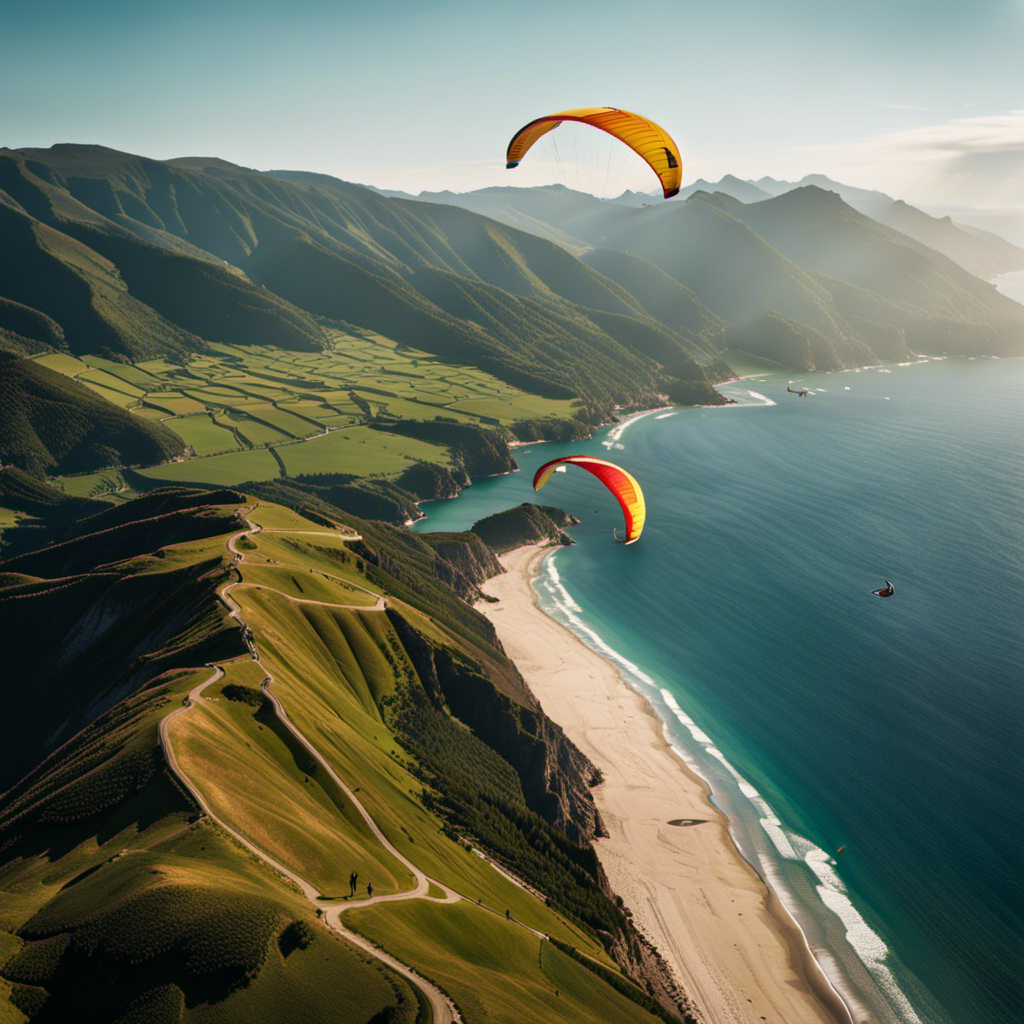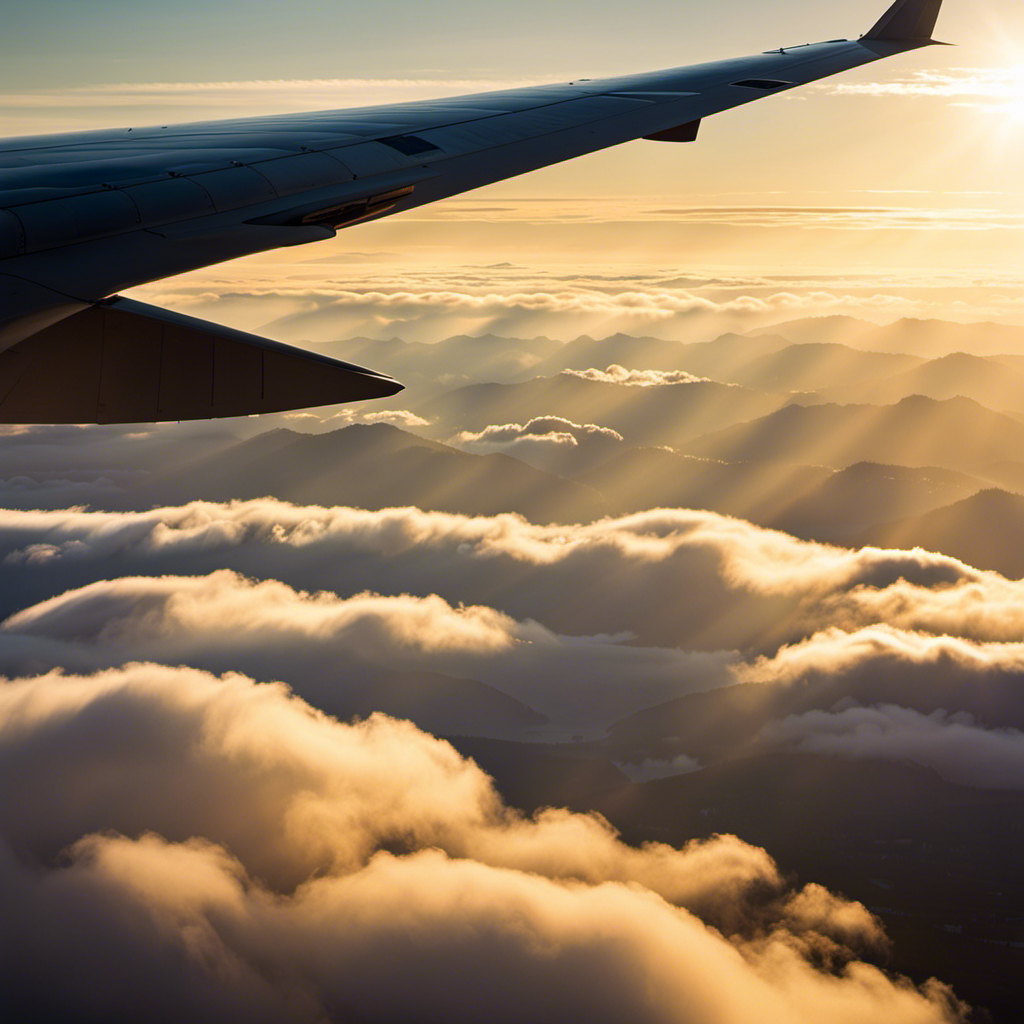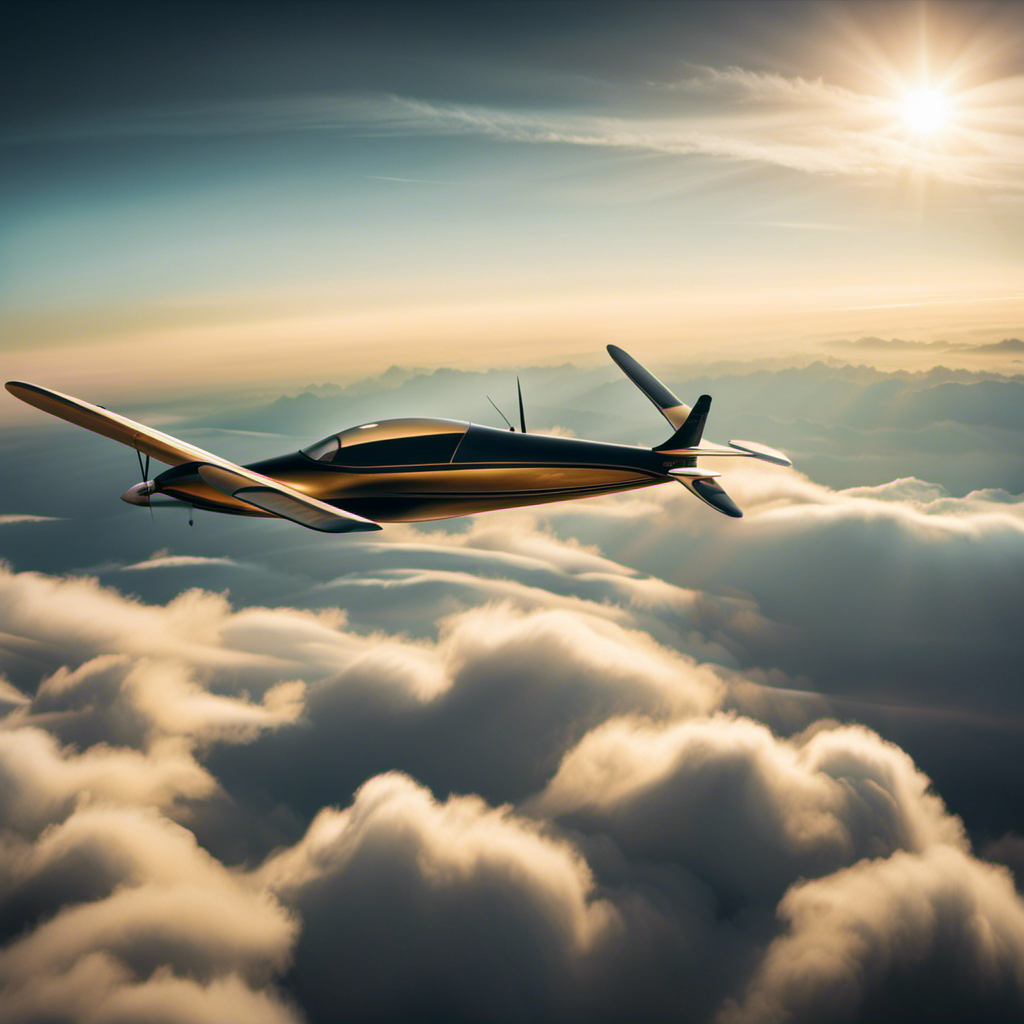Flying through the sky like a bird, the powered hang glider offers an electrifying and exhilarating experience that is truly unparalleled. It provides superior maneuverability and the freedom to soar through the skies, making it a dream come true for adventure enthusiasts.
But before taking flight, it’s important to consider the pros and cons of this unique aircraft. From its accessibility and lower operating costs to its limitations in payload capacity and flight duration, there are several factors to weigh.
Join me as we delve into the world of powered hang gliders and uncover the advantages and disadvantages they bring.
Key Takeaways
- Understanding weather conditions and wind patterns is crucial for a smooth and efficient flight experience
- Flight duration in powered hang gliders is affected by factors such as fuel capacity, weight restrictions, wind patterns, altitude, and cruising speed
- External factors like air traffic and safety regulations need to be considered and prioritized for flight duration and safety
- Possessing necessary flight skills, knowledge of aerodynamics, and adherence to safety regulations are essential for safe powered hang gliding operations.
Increased Maneuverability and Freedom of Flight
With a powered hang glider, you’ll experience increased maneuverability and a greater sense of freedom in flight. The addition of a motor to the hang glider allows for more control over speed and direction, giving the pilot the ability to navigate through the air with ease. This increased maneuverability opens up a whole new world of possibilities for exploration and adventure.
However, it is important to note that with this increased freedom comes the need for increased safety precautions. Pilots must be well-trained and follow strict safety guidelines to ensure a safe flight.
Additionally, it is crucial to consider the impact on the environment. Powered hang gliders emit noise and exhaust, which can disrupt wildlife and contribute to air pollution.
Transitioning to the next section, let’s explore the accessibility and ease of use of powered hang gliders.
Accessibility and Ease of Use
The accessibility and ease of use of a powered hang glider make it a popular choice among thrill-seekers. Powered hang gliders offer a solution to accessibility challenges by eliminating the need for hills or launching ramps. They have user-friendly features such as a simplified control system and intuitive interface, making operating them a breeze.
Picture yourself effortlessly soaring through the sky, guided by the responsive control inputs as you navigate the open air. The feeling of freedom is unparalleled as you witness breathtaking views from a unique vantage point.
With the ability to climb, descend, and maneuver with precision, the powered hang glider offers an exhilarating experience that is sure to leave you craving for more.
Thrilling and Exhilarating Experience
Imagine yourself soaring through the sky, feeling the rush of adrenaline as you navigate the open air in a powered hang glider. The experience is truly exhilarating, as the powerful engine propels you forward, allowing you to reach incredible speeds.
As you gain altitude, the breathtaking aerial views unfold before your eyes, with landscapes stretching out in all directions. The adrenaline rush is unmatched, as you control the glider with precision and skill, feeling the wind against your face and the thrill of being suspended in mid-air. It’s a sensation like no other, where every sense is heightened, and you become one with the elements.
Now, let’s explore another advantage of powered hang gliders, their lower operating costs compared to traditional aircraft.
Lower Operating Costs Compared to Traditional Aircraft
You’ll be pleasantly surprised by how much money you can save when operating a powered hang glider compared to a traditional aircraft. Here are three reasons why:
-
Lower fuel consumption: Powered hang gliders are designed to be highly efficient, using smaller engines and lighter airframes. This means they require less fuel to operate, resulting in significant cost savings over time.
-
Reduced environmental impact: With their smaller engines and lighter weight, powered hang gliders have a much lower carbon footprint compared to traditional aircraft. They produce fewer emissions and consume less fuel, making them a more environmentally friendly option.
-
Lower maintenance costs: Powered hang gliders have simpler mechanics and fewer complex parts compared to traditional aircraft. This translates to lower maintenance and repair costs, saving you money in the long run.
By choosing a powered hang glider, you not only save money but also contribute to a greener and more sustainable aviation industry.
Now, let’s explore their ability to fly in various weather conditions.
Ability to Fly in Various Weather Conditions
When operating in various weather conditions, it’s important to consider the versatility and adaptability of a powered hang glider. These aircraft are designed to handle a wide range of weather conditions, allowing pilots to fly safely and confidently. However, it’s crucial to be aware of the flying limitations and take appropriate safety precautions.
| Flying Limitations | Safety Precautions |
|---|---|
| Limited ability to fly in strong winds | Avoid flying during high wind conditions |
| Susceptibility to turbulence | Maintain a safe altitude and be prepared for sudden changes in air currents |
| Vulnerability to adverse weather conditions | Monitor weather forecasts and plan flights accordingly |
Potential for Long-Distance Flight
By understanding its capabilities and limitations, pilots can effectively plan long-distance flights in a powered hang glider. When it comes to long-distance endurance, powered hang gliders excel due to their efficient engines and fuel capacity. However, pilots must be aware of the navigation challenges they may encounter during these flights.
Here are some key considerations for long-distance flight planning in a powered hang glider:
-
Weather conditions: Monitoring weather patterns is crucial to ensure safe and efficient navigation during long-distance flights.
-
Fuel management: Calculating fuel consumption and planning refueling stops is essential for maintaining continuous power throughout the flight.
-
Route planning: Choosing the most optimal route to minimize navigation challenges, such as strong winds or restricted airspace.
-
Communication: Maintaining effective communication with air traffic control and other pilots is vital for situational awareness and safety.
Considering these factors, pilots can confidently plan their long-distance flights in a powered hang glider. However, one challenge they may face is the limited payload capacity, which will be discussed in the subsequent section.
Limited Payload Capacity
As we explored the potential for long-distance flight in powered hang gliders, it is crucial to consider the limitations of their payload capacity. While these aircraft offer the thrill of soaring through the skies, their ability to carry additional weight is restricted.
Payload limitations are a critical factor to consider when planning flights, as exceeding the weight restrictions can compromise the safety and performance of the hang glider. The weight of the pilot, fuel, and any additional equipment must be carefully managed to ensure that the aircraft remains within its specified limits.
Understanding these payload limitations is essential for pilots to make informed decisions and prioritize safety. Furthermore, it highlights the importance of reliance on weather conditions and wind patterns in determining the feasibility and success of a powered hang glider flight.
Reliance on Weather Conditions and Wind Patterns
To ensure a safe and successful flight, you’ll need to carefully consider weather conditions and wind patterns as you plan your powered hang glider adventure. Flight restrictions and the impact on the flight schedule are crucial factors to consider.
The weather can greatly affect your ability to fly, as certain conditions may impose limitations on your flight. Strong winds, for example, can make it difficult to maintain control and stability in the air. Similarly, adverse weather conditions such as rain, fog, or storms can pose significant risks to your safety. It is essential to monitor weather forecasts and plan your flights accordingly.
By understanding and adapting to the weather conditions and wind patterns, you can ensure a smoother and more enjoyable flight experience.
Now, let’s explore another important aspect of powered hang gliding – limited flight duration.
Limited Flight Duration
When planning your flight, keep in mind that flight duration is limited and can vary depending on various factors such as fuel capacity and weight restrictions.
Flight endurance in powered hang gliders is typically shorter compared to other aircraft due to their smaller fuel capacity. However, advancements in technology have improved fuel efficiency in these aircraft, allowing for longer flights.
To maximize flight duration, pilots should consider factors such as wind patterns, altitude, and cruising speed. Additionally, maintaining proper weight distribution and adhering to weight restrictions is crucial for optimizing fuel efficiency.
It is important to note that flight duration can also be affected by external factors like weather conditions and air traffic. Therefore, it is necessary to plan accordingly and always prioritize safety considerations and training requirements when operating a powered hang glider.
Safety Considerations and Training Requirements
Pilots should always prioritize safety and ensure they meet the necessary training requirements when operating a powered hang glider. Safety regulations play a crucial role in ensuring a safe and enjoyable flight experience. These regulations include proper maintenance of the aircraft, adherence to weight limits, and regular inspections. Additionally, pilots must possess the necessary flight skills to handle unexpected situations and emergencies. This requires thorough knowledge of aerodynamics, weather patterns, and navigation techniques.
To further illustrate the importance of safety and training, let’s take a look at the following table:
| Safety Regulation | Flight Skill | Importance |
|---|---|---|
| Regular inspections | Emergency procedures | High |
| Proper maintenance | Aerodynamics | Medium |
| Weight limits | Weather patterns | Low |
| Adherence to rules | Navigation techniques | High |
| Pilot licensing | Landing techniques | Medium |
Frequently Asked Questions
Are there any weight restrictions for passengers who want to fly in a powered hang glider?
Yes, there are weight restrictions for passengers who want to fly in a powered hang glider. Safety precautions dictate that the weight of the passenger should be within the specified limits to ensure a safe and balanced flight.
How long does it typically take to learn how to fly a powered hang glider?
Learning to fly a powered hang glider has a steep learning curve, but it’s worth the effort. Training duration varies, but on average it takes around 10-15 hours of instruction and practice to become proficient.
Is it possible to fly a powered hang glider in rainy or stormy weather?
In rainy weather, it is important to take precautions when flying a powered hang glider. Safety measures in stormy conditions include avoiding flying in heavy rain or thunderstorms to prevent potential hazards.
Are there any specific age requirements for operating a powered hang glider?
There are specific age requirements for operating a powered hang glider, in accordance with safety regulations. These regulations ensure that individuals have the necessary maturity and physical abilities to operate the aircraft safely.
Can a powered hang glider be used for transportation purposes, such as commuting to work or running errands?
Using a powered hang glider for transportation has both pros and cons. It offers a unique and exhilarating experience, but practicality and efficiency may be an issue. Additionally, the environmental impact should be considered.
Conclusion
In conclusion, the powered hang glider presents a thrilling and exhilarating experience for those seeking increased maneuverability and freedom of flight. Its accessibility and ease of use make it an attractive option for aviation enthusiasts of all levels.
With lower operating costs compared to traditional aircraft, it offers a cost-effective way to enjoy the skies. However, its limited payload capacity and reliance on weather conditions and wind patterns must be considered.
Additionally, safety considerations and training requirements are essential to ensure a safe and enjoyable flight.
With a heart that soars as high as the skies, Aria, affectionately known as “Skylark,” is the driving force behind Soaring Skyways. Her journey into the gliding world began as a young dreamer gazing up at the soaring birds, yearning to experience the weightlessness and freedom they embodied. With years of experience both in the cockpit and behind the scenes, Aria’s commitment to the gliding community is unwavering.










